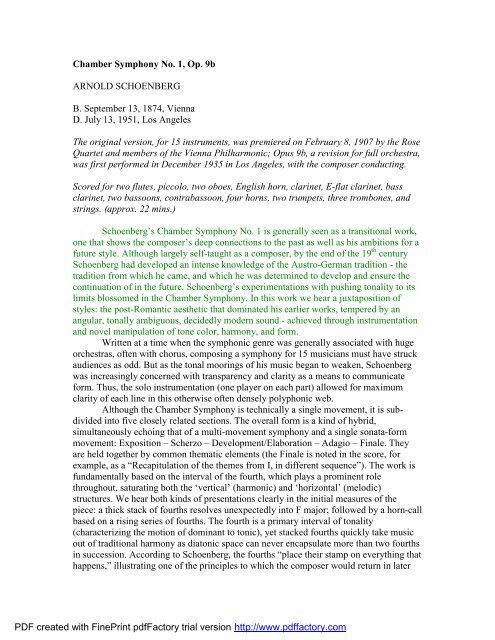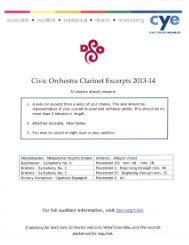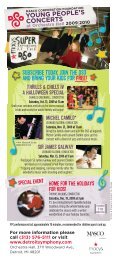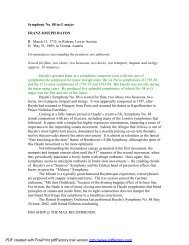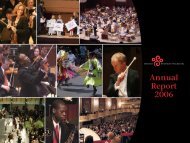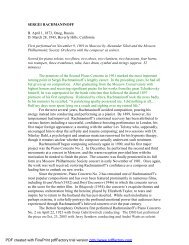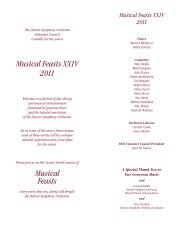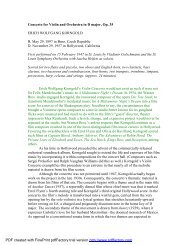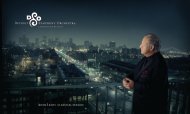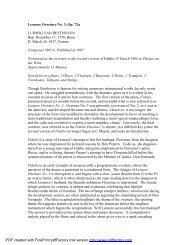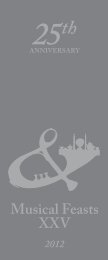Chamber Symphony No. 1, Op. 9b ARNOLD SCHOENBERG B ...
Chamber Symphony No. 1, Op. 9b ARNOLD SCHOENBERG B ...
Chamber Symphony No. 1, Op. 9b ARNOLD SCHOENBERG B ...
- No tags were found...
Create successful ePaper yourself
Turn your PDF publications into a flip-book with our unique Google optimized e-Paper software.
<strong>Chamber</strong> <strong>Symphony</strong> <strong>No</strong>. 1, <strong>Op</strong>. <strong>9b</strong><br />
<strong>ARNOLD</strong> <strong>SCHOENBERG</strong><br />
B. September 13, 1874, Vienna<br />
D. July 13, 1951, Los Angeles<br />
The original version, for 15 instruments, was premiered on February 8, 1907 by the Rose<br />
Quartet and members of the Vienna Philharmonic; <strong>Op</strong>us <strong>9b</strong>, a revision for full orchestra,<br />
was first performed in December 1935 in Los Angeles, with the composer conducting.<br />
Scored for two flutes, piccolo, two oboes, English horn, clarinet, E-flat clarinet, bass<br />
clarinet, two bassoons, contrabassoon, four horns, two trumpets, three trombones, and<br />
strings. (approx. 22 mins.)<br />
Schoenberg’s <strong>Chamber</strong> <strong>Symphony</strong> <strong>No</strong>. 1 is generally seen as a transitional work,<br />
one that shows the composer’s deep connections to the past as well as his ambitions for a<br />
future style. Although largely self-taught as a composer, by the end of the 19 th century<br />
Schoenberg had developed an intense knowledge of the Austro-German tradition - the<br />
tradition from which he came, and which he was determined to develop and ensure the<br />
continuation of in the future. Schoenberg’s experimentations with pushing tonality to its<br />
limits blossomed in the <strong>Chamber</strong> <strong>Symphony</strong>. In this work we hear a juxtaposition of<br />
styles: the post-Romantic aesthetic that dominated his earlier works, tempered by an<br />
angular, tonally ambiguous, decidedly modern sound - achieved through instrumentation<br />
and novel manipulation of tone color, harmony, and form.<br />
Written at a time when the symphonic genre was generally associated with huge<br />
orchestras, often with chorus, composing a symphony for 15 musicians must have struck<br />
audiences as odd. But as the tonal moorings of his music began to weaken, Schoenberg<br />
was increasingly concerned with transparency and clarity as a means to communicate<br />
form. Thus, the solo instrumentation (one player on each part) allowed for maximum<br />
clarity of each line in this otherwise often densely polyphonic web.<br />
Although the <strong>Chamber</strong> <strong>Symphony</strong> is technically a single movement, it is subdivided<br />
into five closely related sections. The overall form is a kind of hybrid,<br />
simultaneously echoing that of a multi-movement symphony and a single sonata-form<br />
movement: Exposition – Scherzo – Development/Elaboration – Adagio – Finale. They<br />
are held together by common thematic elements (the Finale is noted in the score, for<br />
example, as a “Recapitulation of the themes from I, in different sequence”). The work is<br />
fundamentally based on the interval of the fourth, which plays a prominent role<br />
throughout, saturating both the ‘vertical’ (harmonic) and ‘horizontal’ (melodic)<br />
structures. We hear both kinds of presentations clearly in the initial measures of the<br />
piece: a thick stack of fourths resolves unexpectedly into F major; followed by a horn-call<br />
based on a rising series of fourths. The fourth is a primary interval of tonality<br />
(characterizing the motion of dominant to tonic), yet stacked fourths quickly take music<br />
out of traditional harmony as diatonic space can never encapsulate more than two fourths<br />
in succession. According to Schoenberg, the fourths “place their stamp on everything that<br />
happens,” illustrating one of the principles to which the composer would return in later<br />
PDF created with FinePrint pdfFactory trial version http://www.pdffactory.com
compositions when challenged with creating unity and structure in the absence of tonal<br />
organization.<br />
The character of the original composition is considerably changed in the revision<br />
for full orchestra that we hear tonight. Schoenberg completed this version less than two<br />
years after fleeing Europe in light of Hitler’s rise to power and arriving in the United<br />
States. It was a rather curious time in Schoenberg’s musical output: three of Schoenberg’s<br />
major compositions from that year were somewhat neo-classical and tonal in nature,<br />
based on forms and pieces from the 18 th century. Perhaps Schoenberg’s glances to the<br />
past encouraged him to revisit his own earlier work. If the ascetic, angular chamber<br />
version pointed toward Schoenberg’s modernist future, this orchestral version, which<br />
draws out the work’s lush post-Romanticism, points to his past.<br />
The Detroit <strong>Symphony</strong> Orchestra last performed Schoenberg’s <strong>Chamber</strong><br />
<strong>Symphony</strong> <strong>No</strong>. 1 on Jan. 26, 1961, with Eleazar de Carvalho conducting.<br />
DSO SHOP @ THE MAX RECOMMENDS:<br />
Schoenberg, <strong>Chamber</strong> <strong>Symphony</strong> <strong>No</strong>. 1, Heinz Holliger conducting the <strong>Chamber</strong><br />
Orchestra of Europe, Teldec 44399.<br />
PDF created with FinePrint pdfFactory trial version http://www.pdffactory.com


